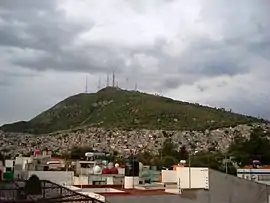Cerro del Chiquihuite
Cerro del Chiquihuite (Chiquihuite Hill) is a hill located in the north of Mexico City, in the borough of Gustavo A. Madero and bordering the municipality of Tlalnepantla de Baz in the State of Mexico. The hill has a height of 2,730 metres (8,960 ft) above sea level and forms part of the Sierra de Guadalupe mountain range.
| Cerro del Chiquihuite | |
|---|---|
 Cerro del Chiquihuite in 2007 | |
| Highest point | |
| Elevation | 2,730 m (8,960 ft) |
| Coordinates | 19°31′58″N 99°07′50″W |
| Naming | |
| English translation | Chiquihuite Hill |
| Language of name | Spanish |
| Geography | |
| Location | Mexico City; Tlalnepantla de Baz, State of Mexico |
It was used as a filming location for the 1993 Mexican film Lolo.[1]
Geology
The Cerro del Chiquihuite is a volcanic exogenic dome made of andesitic rock deposited in layers of varying thickness that show signs of extreme weathering. In the past, Chiquihuite had springs of water scattered over its surface, but with the passing of years, these springs have diminished in size.
Historically the mountain has housed several springs, but most of these have dried up. For instance, in the borough of Lázaro Cárdenas, only the largest of these, known as "El Pocito", still flows.
The mountain is rather heavily developed and is prone to landslides; in 1987, 15 people were killed by mudslides off Cerro del Chiquihuite and La Presa hills after heavy rains hit Mexico City.[2]
History
The chiquihuitazo
On December 27, 2002, armed guards hired by Televisión Azteca stormed and took over the transmitter facilities of XHTVM-TV channel 40, which are located on the mountain.[3] The takeover, which stemmed from a contractual and legal dispute over a 1998 contract between XHTVM's owners and Azteca, led to a series of events, negotiations and public debate known as the chiquihuitazo, after the mountain, that resulted in XHTVM's owners rebuffing Azteca's forceful attempt to retake the station.
The chiquihuitazo resulted in a song, "No Te Metas con mi Chiquihuite" (Don't Mess with My Chiquihuite), produced by a program that aired on Canal 40 at the time.
15th Century: The Templo Mayor
During the 15th century, the Cerro del Chiquihuite was located on the shores of Lake Texcoco, some 9 to 12 kilometers from the heart of the Aztecan empire, Tenochtitlán. The Cerro del Chiquihuite was made principally of a pinkish and violet rock called andesita de lamprobolita,[4] an extrusive igneous rock. One of the principle merits of this rock is the pseudo stratification of its deposited layers of varying thickness. This characteristic allows for flat cuts of stone to be obtained with ease to be used for the tiling of the floor, corners and overhead masonry. Among the towns located in the basin of Mexico, this type of rock was known as Tenayocátetl (Piedra de Tenayuca),[5] and was used in the construction of the Templo Mayor.[6]
Broadcasting
A road leads to the top of the mountain, where transmitters are located for five FM radio stations and eleven television stations,[7] as well as other telecommunications equipment.
Television stations
- XHDF-TDT, channel 1 virtual/25 digital
- XHTDMX-TDT, channel 6 virtual/11 digital
- XHIMT-TDT, channel 7 virtual/24 digital
- XEIPN-TDT, channel 11 virtual/33 digital
- XHCDM-TDT, channel 21 digital
- XEIMT-TDT, channel 22 virtual/23 digital
- XHTRES-TDT, channel 28 virtual/27 digital
- XHSPR-TDT, channel 30 digital
- XHTVM-TDT, channel 40 virtual/26 digital
- XHHCU-TDT, channel 45 virtual/18 digital
Radio stations
Five stations owned by Grupo Radio Centro maintain backup facilities on Cerro del Chiquihuite. They were relocated to a new facility at Villa Alpina, Naucalpan, State of Mexico, in August 2012.[9]:50
References
- César Huerta. "Crearán una memoria cinematográfica en el DF." El Universal 13 November 2009
- Associated Press. "Mexico City storm spurs killer slides." Houston Chronicle 30 May 1987
- Osterroth, Maria, and Ariadna Garcia. "Denuncia CNI toma violenta - TV Azteca rechaza que haya usado la fuerza para hacerse cargo del Canal 40." El Norte 28 December 2002.
- Lujan Leonardo, Aurora Montufar, and Jaime Torres. “Los Materiales Constructivos del Templo Mayor de Tenochtitlan.” Estudios de Cultura Náhuatl, Vol. 34 , 2003, pp. 137–158, http://www.mesoweb.com/about/articles/Materiales-constructivos.pdf. Accessed 6 Mar, 2017.
- Ruedrich Jeorg, Siegfried Siegesmund, and Wanja Wedekind. “Natural building stones of Mexico–Tenochtitlan: their use, weathering and rock properties at the Templo Mayor, Palace Heras Soto and the Metropolitan Cathedral.” Environ Earth Sci, Vol. 62, pp. 1787–1798, http://content.ebscohost.com/ContentServer.asp?EbscoContent=dGJyMNLr40SeprU4y9fwOLCmr0%2Bepq9SsK%2B4SrGWxWXS&ContentCustomer=dGJyMPGuskyurK5IuePfgeyx43zx1%2BqE&T=P&P=AN&S=R&D=iih&K=62614507. Accessed 6 Mar, 2017.
- Moctezuma, Eduardo Matos. The Great Temple of the Aztecs: Treasures of Tenochtitlan. London, Thames and Hudson, 1998.
- Instituto Federal de Telecomunicaciones. Infraestructura de Estaciones de TDT. Last modified 2018-05-16. Retrieved 2014-12-17. Technical information from the IFT Coverage Viewer.
- IFT: "ESTUDIOS TÉCNICOS DE OPERACIÓN DE ESTACIONES DE RADIODIFUSIÓN EN FM CON SEPARACIONES INFERIORES A 800 KHZ ENTRE SUS PORTADORAS PRINCIPALES", 2015, page 18 of 32
- Grupo Radio Centro Annual Report 2015
